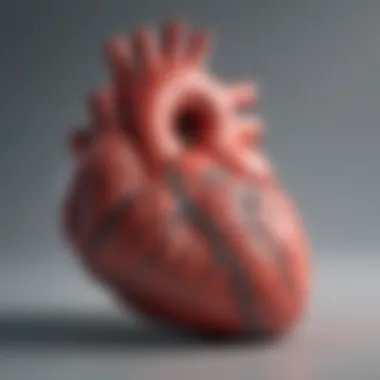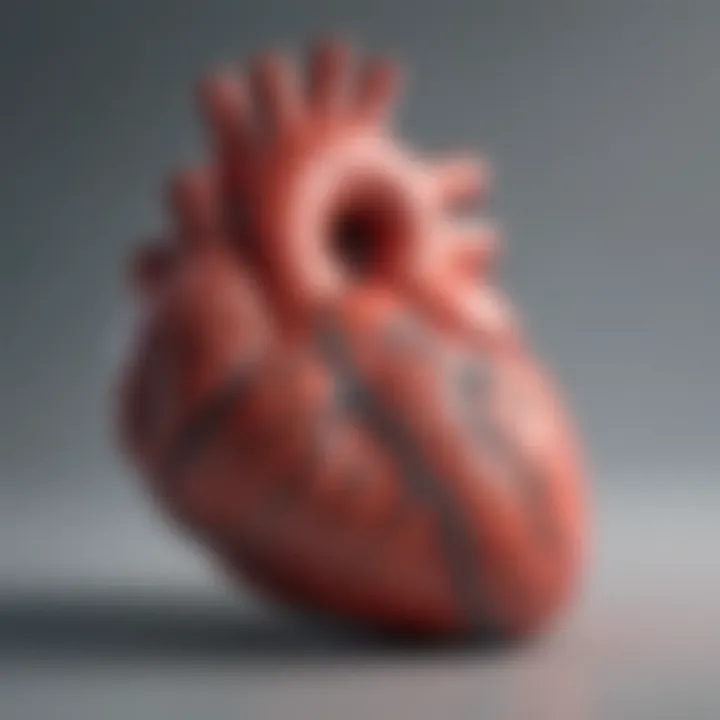Understanding the Causes of Systolic Murmurs


Intro
Systolic murmurs are heart sounds that occur during the contraction phase of the heart's cycle. Understanding these sounds is crucial for clinicians as they can indicate a wide range of cardiovascular conditions. Differentiating between benign and pathological murmurs can significantly influence patient management and prognosis.
This article aims to explore the various causes of systolic murmurs, highlighting normal physiological occurrences and various pathological conditions. Through detailed examination, it will provide a comprehensive understanding of how these murmurs are diagnosed and managed in clinical practice.
Key Findings
Major Results
The exploration of systolic murmurs reveals several key findings. First, it is important to note that not all murmurs indicate heart disease. Many systolic murmurs can be classified as innocent or physiological. For example, children and adolescents often present with benign murmurs due to increased blood flow during periods of growth.
Conversely, certain pathological conditions warrant closer examination. These include:
- Aortic Stenosis: A condition where the aortic valve becomes narrow, altering blood flow.
- Mitral Regurgitation: This involves the backflow of blood into the left atrium due to improper closure of the mitral valve.
- Hypertrophic Cardiomyopathy: A genetic condition that causes thickening of the heart muscle.
These conditions can lead to significant alterations in heart function if left unaddressed.
Discussion of Findings
The implications of systolic murmurs extend beyond mere detection. Understanding their causes, whether benign or pathological, is vital for patient care. For instance, innocent murmurs usually require no specific treatment, while murmurs resulting from valvular abnormalities may require surgical intervention or ongoing management. Identifying the nature of the murmur can streamline the diagnostic process and prioritize patient treatment effectively.
Methodology
Research Design
This section outlines the methodology utilized to gather data on systolic murmurs. A combination of literature review and clinical case studies serves as the foundation for this exploration. Peer-reviewed journals and clinical guidelines were systematically analyzed to discern patterns and associations within the literature.
Data Collection Methods
Data collection methods involved the analysis of both qualitative and quantitative research. Patient cases illustrating different murmurs were reviewed, focusing on clinical presentations and outcomes. Furthermore, data from recent studies provided insights into diagnostic practices. Engaging with meticulous records ensures comprehensive coverage of the relevant topics surrounding systolic murmurs.
Understanding Systolic Murmurs
Systolic murmurs represent a unique aspect of cardiovascular health. Understanding them is essential for medical professionals, students, and researchers alike. These heart sounds can provide valuable insights into the functional state of the heart during its contraction phase. An awareness of their characteristics and potential implications is beneficial to anyone involved in the assessment of heart health.
Systolic murmurs occur during the systolic phase of the cardiac cycle, which is when the heart contracts to pump blood throughout the body. Identifying these murmurs can help clinicians differentiate between normal variations and those stemming from more significant underlying conditions. The clinical implications can range from benign murmurs associated with youthful hearts to those indicating serious heart valve abnormalities.
By thoroughly understanding the features of systolic murmurs, medical practitioners can quickly establish a pathway to further investigation if needed. This can include various diagnostic methodologies, contributing to patient outcomes and management strategies. Consequently, comprehension of the causes and significances of these heart sounds cannot be overemphasized. It fosters a proactive rather than reactive approach to cardiovascular health.
Definition and Characteristics
A systolic murmur is defined as an abnormal sound produced during the systolic phase of the cardiac cycle. Murmurs are classified based on their timing, intensity, and quality. The sounds result from turbulent blood flow within the heart or its major vessels. Interestingly, not all murmurs signify pathology; some can be entirely benign.
Key characteristics of systolic murmurs include the following:
- Timing: These murmurs are typically heard between the first heart sound (S1) and the second heart sound (S2).
- Intensity: Ranges from faint to loud, often graded on a scale from 1 to 6 based on their audibility.
- Quality: May be described as harsh, blowing, or musical, depending on the underlying cause of the turbulence.
Innocent murmurs are common in children and often arise from high blood flow velocities, which typically resolve as the child matures. Meanwhile, pathological murmurs might indicate underlying heart disease, such as valvular abnormalities or congenital heart defects.
Phonocardiography and Auscultation
Phonocardiography and auscultation are the primary techniques used to assess heart sounds and murmurs. Auscultation involves listening to the sounds produced by the heart using a stethoscope. This method is critical in diagnosing systolic murmurs and requires significant skill and experience.
Phonocardiography, on the other hand, is a more advanced technique. It produces a visual representation of heart sounds, allowing for a detailed analysis of timing, intensity, and duration. This modality enhances the traditional methods of auscultation and provides valuable data for further evaluation.
Systolic murmur identification requires careful analysis by the clinician. Key considerations include:
- Location: Where the murmur is best heard on the chest can guide potential diagnoses.
- Radiation: Whether the sound travels or remains localized can indicate specific heart diseases.
- Respiratory Variation: Observing changes during inhalation or exhalation can provide additional context.
Understanding the nuances of phonocardiography combined with auscultation is critical in clinical practice, helping to ensure accurate interpretations and appropriate patient management.
In summary, recognizing the characteristics of systolic murmurs is crucial. These techniques form the backbone of cardiac assessment, allowing clinicians to navigate the complex world of heart sounds.
Physiological Causes of Systolic Murmurs
Understanding the physiological causes of systolic murmurs is crucial for clinicians and researchers alike. These murmurs are often benign and occur in healthy individuals or under normal physiological conditions. Recognizing the circumstances under which these murmurs develop can help differentiate them from pathological murmurs, which may indicate serious underlying heart problems. This distinction is important as it affects how patients are managed and treated.
Physiological murmurs usually arise when blood flow across the heart valves increases. This increased flow can be related to various factors including activity levels, anatomical differences, and even hormonal changes. It is essential for healthcare professionals to grasp these causes, as they often present in populations such as children or pregnant women, where the prevalence of innocent murmurs tends to be higher.


Innocent Murmurs in Children
Innocent murmurs, also known as functional or benign murmurs, are quite common in pediatric patients. These murmurs typically arise from normal blood flow across the heart due to a rapid heartbeat, often observed in young children. In healthy children, these sounds are generally transient and not indicative of any structural heart disease.
Several key factors contribute to the occurrence of innocent murmurs in this demographic:
- High Cardiac Output: Children possess higher metabolic rates, requiring increased blood circulation, leading to the generation of murmurs.
- Thin Chest Wall: The physical structure of a child's chest allows heart sounds to be more readily transmitted.
- Changes in Position: Different body positions during examination can impact blood flow dynamics, further influencing sound generation.
It's important for physicians to recognize these murmurs during routine examinations. Misinterpretation can lead to unnecessary worry for parents, as well as unwarranted testing or referrals.
Physiological Changes in Pregnant Women
Pregnancy brings about significant anatomical and physiological changes in a woman's body. One notable change includes increased blood volume, which can lead to the development of systolic murmurs. During pregnancy, a woman's blood volume can increase by 30-50%, creating additional turbulence as the heart pumps this extra volume.
Some distinctive factors affecting pregnant women include:
- Increased Blood Flow: Higher volume demands across the circulatory system ultimately lead to increased blood flow across the valves.
- Hormonal Changes: Hormones like estrogen and progesterone affect vascular compliance and can alter the hemodynamics of blood flow.
- Cardiac Output Variation: There is often a 20-40% increase in cardiac output during pregnancy which can also cause murmurs due to greater blood flow speed.
Monitoring these physiological murmurs is vital during prenatal care to ensure no underlying cardiac issues are present, especially since maternal health directly affects fetal well-being.
Understanding these physiological causes helps to alleviate anxiety in patients and guides appropriate clinical management.
Physiological murmurs in both children and pregnant women often resolve without intervention. However, the awareness surrounding these specific causes can lead to better patient outcomes and more informed clinical practices.
Pathological Causes of Systolic Murmurs
Understanding the pathological causes of systolic murmurs is essential for diagnosing and managing potential cardiovascular issues. Systolic murmurs can be indicative of underlying health problems, and knowing their origins is crucial for healthcare professionals. The pathological causes can involve various heart conditions, primarily those affecting the heart valves, cardiac muscle, and structural heart defects. This section will delve into the specifics of these causes, enhancing the reader's comprehension of how they impact cardiovascular health.
Valvular Heart Diseases
Valvular heart diseases are among the most common pathological causes of systolic murmurs. These conditions occur when the heart's valves do not function properly, leading to turbulent blood flow. The importance of understanding these diseases lies in their prevalence and potential for serious complications. Diagnosing valvular abnormalities can prompt timely intervention, improving patient outcomes.
Aortic Stenosis
Aortic stenosis is characterized by the narrowing of the aortic valve opening. This condition causes a significant pressure gradient between the left ventricle and the aorta during systole. The key characteristic of aortic stenosis is the high-pitched, crescendo-decrescendo systolic ejection murmur heard best at the right second intercostal space. Its prominence in this article is due to its relatively common occurrence and serious implications, such as heart failure and arrhythmias.
The unique feature of aortic stenosis is that it often develops gradually, often going unnoticed until symptoms become severe. This delayed presentation can be a disadvantage, as it may result in advanced heart disease before diagnosis. Regular monitoring through echocardiography plays a vital role in management, allowing for timely surgical intervention when necessary.
Mitral Regurgitation
Mitral regurgitation is the backflow of blood from the left ventricle into the left atrium during systole due to the failure of the mitral valve to close completely. The murmur created by this condition is typically described as a holosystolic or pansystolic murmur. One benefit of including mitral regurgitation in this article is its common association with a variety of cardiac conditions, which broadens the understanding of heart disease.
A unique aspect of mitral regurgitation is its capacity to remain asymptomatic for extended periods. However, this can potentially mislead clinicians, complicating the decision-making process regarding treatment. Early detection can significantly alter the prognosis and prevent progression to more severe heart conditions.
Cardiomyopathy
Cardiomyopathy encompasses several diseases affecting the heart muscle. It contributes significantly to systolic murmurs by altering cardiac structure and function, leading to impaired blood flow and potential heart failure. Understanding cardiomyopathy is crucial for recognizing the diverse presentations of heart disease.
Hypertrophic Cardiomyopathy
Hypertrophic cardiomyopathy is characterized by abnormal thickening of the heart muscle, which can obstruct blood flow and lead to systolic murmurs. Its key characteristic is the presence of a loud, systolic ejection murmur that may increase with maneuvers like a Valsalva maneuver. It is relevant to this article due to its genetic basis and high risk of sudden cardiac death in young athletes.
This condition's unique feature is its variable presentation; some patients may be asymptomatic while others experience significant symptoms. Due to its hereditary nature, family screening is often recommended, thus presenting both an advantage and disadvantage in clinical practice.
Dilated Cardiomyopathy
Dilated cardiomyopathy involves dilation and dysfunction of the heart chambers, leading to decreased contractility. The presence of a systolic murmur often arises from mitral regurgitation secondary to left ventricular dilation. This condition is noteworthy for its high prevalence as a cause of heart failure.
The unique aspect of dilated cardiomyopathy is its association with various etiologies, including genetic factors, infections, and drug toxicity, making diagnosis and management more complex. Early detection can significantly affect outcomes, emphasizing the need for awareness among healthcare professionals.
Congenital Heart Defects
Congenital heart defects are structural abnormalities of the heart present at birth, which can lead to various types of murmurs, including systolic ones. Recognizing these defects is crucial in pediatric populations as they can range from benign to life-threatening.
Ventricular Septal Defect
A ventricular septal defect is a hole in the wall separating the heart's ventricles, allowing blood to flow abnormally. This condition typically produces a loud, holosystolic murmur that can be easily detected. Its inclusion in this article is valuable due to its prevalence among congenital heart defects.
A significant advantage of understanding ventricular septal defects is the potential for spontaneous closure, especially in smaller defects, reducing the need for surgical intervention. However, larger defects may lead to complications if left untreated.
Patent Ductus Arteriosus


Patent ductus arteriosus occurs when the ductus arteriosus fails to close after birth, allowing blood to pass from the aorta to the pulmonary artery. This situation results in a continuous murmur, often described as “machine-like.” Addressing it within this article highlights its incidence in premature infants and conveys the importance of early diagnosis and treatment.
The unique feature of patent ductus arteriosus is that its closure may be achieved through both medical and surgical means, with varying degrees of success. Understanding this condition fosters awareness among healthcare providers to consider it during neonatal assessments.
Clinical Significance of Systolic Murmurs
Understanding the clinical significance of systolic murmurs is crucial for healthcare professionals. These heart sounds, while not always indicative of a serious problem, can signal various cardiovascular issues. Their presence needs careful consideration, as they may arise from both innocent physiological changes or serious pathological conditions.
Systolic murmurs often require detailed evaluation to determine their origin. This process is vital for patient management and treatment. Early recognition of significant murmurs can lead to timely interventions. Below are some key elements related to the clinical significance of these murmurs:
- Differentiation: Distinguishing between benign and pathological murmurs is essential for appropriate patient care.
- Patient Context: The clinical history, including symptoms and patient demographics, affects interpretation. Understanding if the murmur is physiological or pathological is key.
- Ongoing Monitoring: Some murmurs necessitate follow-up to ensure they do not progress to more serious conditions.
"The presence of a systolic murmur can denote a broad spectrum of cardiac conditions, highlighting the need for thorough investigation."
Evaluation and Differential Diagnosis
Evaluating systolic murmurs involves a systematic approach. Healthcare providers assess the intensity, timing, and quality of the murmur. This evaluation guides differential diagnosis, allowing for the identification of the underlying cause:
- Location: Determining where the murmur is loudest aids in identifying the likely cardiac structure involved.
- Radiation: Understanding if the murmur radiates to other areas, such as the neck, can provide insights into specific pathologies.
- Associated Symptoms: Any accompanying findings, like shortness of breath or chest pain, necessitate immediate consideration.
Pathway to Further Investigation
When a systolic murmur is detected, further diagnostic tests may be needed to explore the underlying cause more thoroughly. This may involve advanced imaging techniques, such as echocardiography and cardiac MRI.
Echocardiography
Echocardiography is a primary tool in assessing cardiac murmurs. It uses sound waves to create real-time images of the heart.
- Key Characteristic: The non-invasive nature of this procedure makes it a preferred first step in investigation.
- Unique Feature: It provides detailed visual information about heart structure and function.
- Advantages: Echocardiography is widely available and relatively quick, allowing for efficient diagnosis. There are few risks involved, making it suitable for a broad range of patients. However, it is operator-dependent, meaning accuracy can vary based on the technician's skill.
Cardiac MRI
Cardiac MRI offers another level of detail. This technique provides high-resolution images and functional information about the heart.
- Key Characteristic: Unlike echocardiography, MRI does not depend on operator skill as heavily, providing consistent results.
- Unique Feature: It can assess myocardial tissues, offering insights into conditions not easily visible through other modalities.
- Advantages: Cardiac MRI is excellent for evaluating complex heart structures and iron overload conditions. However, it can be time-consuming and requires specific equipment that may not be available everywhere.
Conclusively, understanding the clinical significance and employing appropriate diagnostic pathways is essential. This knowledge ensures optimal patient management and treatment outcomes for those with systolic murmurs.
Management Strategies for Systolic Murmurs
Understanding the management strategies for systolic murmurs is crucial for both clinicians and patients. Effective management can significantly impact patient outcomes, especially in differentiating between benign murmurs and those indicating serious cardiac issues. The approach to management often depends on the underlying cause of the murmur, its characteristics, and the patient's overall health.
The two primary strategies for managing systolic murmurs include observation and monitoring, as well as surgical interventions. Each approach has its own benefits and considerations, emphasizing the importance of a nuanced understanding of the condition.
Observation and Monitoring
Observation and monitoring are common practices for patients with benign systolic murmurs. This strategy is particularly pertinent in pediatric populations, where innocent murmurs are frequent. Regular follow-up appointments allow healthcare providers to assess any changes in the murmur’s characteristics or related symptoms.
Benefits of this strategy include:
- Non-invasiveness: Continuous monitoring avoids unnecessary procedures.
- Patient comfort: Patients often feel reassured when they know their health is being tracked.
- Early detection: Monitoring allows for quick intervention should a murmur indicate a pathologic change over time.
However, there are challenges. Providers must ensure clear communication with patients and families regarding what to observe and when to seek additional care. There may be anxiety or confusion in cases where murmurs fluctuate without clear causes, necessitating careful education on the condition.
Surgical Interventions
When systolic murmurs are indicative of underlying pathological conditions, surgical interventions may be required. These procedures aim to rectify structural heart issues that contribute to the abnormal sounds. There are two primary surgical strategies:
Valvuloplasty
Valvuloplasty is a procedure designed to repair narrowed heart valves, notably in conditions like aortic stenosis. This intervention involves the insertion of a balloon catheter to widen the valve opening, enhancing blood flow.
Key characteristics of valvuloplasty include:
- Minimally invasive approach: It generally involves less recovery time and lower hospital stays compared to more extensive surgeries.
- Immediate effect: Patients often experience rapid improvements in symptoms following the procedure.
The unique feature of valvuloplasty lies in its ability to preserve the valve's structure without replacement. Its advantages make this procedure a popular choice among clinicians. However, potential disadvantages should also be considered, such as:
- Recurrence of stenosis: Some patients may experience a return of symptoms, necessitating further interventions.
- Not suitable for all patients: Those with significant valve calcification may require other treatments.


Valve Replacement
Valve replacement is indicated when valvuloplasty is insufficient to restore function. This surgical procedure involves removing a malfunctioning valve and replacing it with a mechanical or biological valve.
The key characteristic of valve replacement is its definitive result; unlike valvuloplasty, valve replacement permanently resolves significant valvular heart disease. Benefits of valve replacement include:
- Long-term solution: For chronic issues, valve replacement can significantly enhance quality of life.
- Improved hemodynamics: Patients often experience normalization of blood flow dynamics post-surgery.
One distinct feature of valve replacement is the choice between mechanical and biological valves, each with its own set of considerations for anticoagulation and lifestyle changes. However, with advantages come disadvantages:
- Surgical risks: As with any open-heart procedure, there are inherent risks such as infection or complications from anesthesia.
- Lifelong follow-up: Patients with mechanical valves typically require long-term anticoagulation therapy, impacting their lifestyle choices.
Contemporary Research on Systolic Murmurs
Recent advancements in the understanding and diagnostic methods surrounding systolic murmurs have underscored the importance of contemporary research in cardiology. This section explores how emerging technologies and innovative approaches are reshaping the landscape of systolic murmur assessment and management. The ability to differentiate between benign and pathological murmurs is vital for effective patient care. As research continues to evolve, it produces new insights that can enhance clinical practices and improve patient outcomes.
Emerging Diagnostic Techniques
Emerging diagnostic techniques are central to the ongoing research on systolic murmurs. New methods aim to provide greater accuracy and detail in identifying the underlying causes. One significant advancement is the use of advanced echocardiography. Techniques such as three-dimensional echocardiography allow for more precise imaging of cardiac structures. This enhances the clinician's ability to identify abnormalities that contribute to murmur development.
Another area of progress is the incorporation of artificial intelligence in the interpretation of auscultation sounds. Machine learning algorithms can analyze heart sounds with remarkable accuracy, potentially flagging subtle variations that human examiners might miss. This not only promotes timely diagnosis but can also prevent misdiagnosis.
Wearable technologies are gaining traction as well. Devices that continuously monitor heart sounds throughout daily activities can provide invaluable data. They enable clinicians to track changes over time, guiding treatment decisions effectively. The integration of this data with telehealth solutions can foster patient engagement and enable remote monitoring, expanding access to high-quality care.
"Emerging diagnostic techniques are transforming the approach to systolic murmurs, enabling earlier diagnosis and more tailored management strategies."
Future Directions in Treatment
As cardiology research progresses, several future directions in treatment for conditions associated with systolic murmurs become apparent. Targeted therapies that address the specific pathophysiological mechanisms behind murmurs are an exciting prospect. Recent studies are exploring pharmacological agents that can improve heart function or reduce structural abnormalities. For instance, targeted therapies aimed at valvular heart diseases and cardiomyopathies are entering clinical trials, suggesting a shift toward more individualized treatment plans.
Additionally, minimally invasive surgical techniques are under evaluation. Procedures like catheter-based interventions aim to correct structural issues without the need for open-heart surgery. Research is also looking into regenerative medicine, including the use of stem cells for tissue repair, which can fundamentally alter the management of conditions associated with systolic murmurs.
In summary, ongoing research into systolic murmurs is not just about understanding their causes, but also about enhancing diagnostic precision and treatment effectiveness. By focusing on innovative technologies and therapeutic strategies, we can hope to improve the overall cardiovascular health outcomes for patients.
The developments discussed in these subsections symbolize a commitment to advancing the field of cardiology, providing a more profound comprehension of systolic murmurs in both clinical and research contexts.
Case Studies Illustrating Systolic Murmurs
The exploration of case studies involving systolic murmurs serves integral purpose to this article. Case studies provide real-world context, enhancing theoretical knowledge with practical examples. By examining individual cases, medical professionals can better understand the presentation and implications of systolic murmurs in diverse patients. Furthermore, these examples highlight diagnostic challenges and management strategies that are faced in clinical settings.
Through detailed analysis, case studies can illustrate variations in symptoms, underlying pathologies, and how murmur characteristics can indicate specific heart conditions. The attention to specific cases aids in the transition from theory to practice, encouraging critical thinking among practitioners, especially in distinguishing between benign and pathological murmurs.
Case Analysis of Aortic Stenosis
A case analysis of aortic stenosis reveals the clinical intricacies associated with this condition. In a typical scenario, a 70-year-old male presents with exertional dyspnea and a characteristic systolic ejection murmur heard best at the right second intercostal space. This patient history emphasizes the common symptomatology of aortic stenosis, which may include fatigue, angina, and syncope.
Upon auscultation, the murmur is described as a crescendo-decrescendo type, which is typical for this pathology. The timing and quality of the murmur are crucial for differential diagnosis. Further investigation often involves echocardiography, which can provide detailed information on aortic valve morphology and left ventricular function.
Management may vary depending on severity, but many patients benefit from surgical intervention such as valve replacement. A thorough understanding of aortic stenosis is essential for timely diagnosis and effective treatment. The case of aortic stenosis highlights not just the significance of clinical findings, but also the necessity of follow-up and continuous patient assessment.
Case Study on Mitral Regurgitation
In contrast, a case study on mitral regurgitation offers insightful perspective on how this condition presents differently. Consider a 45-year-old woman who experiences palpitations and fatigue. Upon examination, a holosystolic murmur is noted, best heard at the apex of the heart and may radiate to the left axilla. This case depicts the distinct characteristics and implications of mitral regurgitation.
Using echocardiography to evaluate the left atrial size and ventricular function helps guide management decisions. In this case, the patient’s symptoms indicate that the regurgitation is significant, prompting discussions about surgical options versus medical management. Once again, this case underscores the complexity and varied presentations of systolic murmurs.
Understanding these case studies not only enhances knowledge but also emphasizes the importance of individualized patient care in managing cardiac conditions.
Culmination
The conclusion drawn from this article is essential to understand the overall landscape of systolic murmurs. These heart sounds are not merely clinical findings; they can indicate a range of physiological and pathological states. Recognizing their significance can aid in more effective patient management and treatment decisions.
A recap of the explored causes highlights the diversity in systolic murmurs, from innocent variations in children to serious valvular heart disease. This understanding enables healthcare professionals to differentiate between benign and concerning murmurs effectively. Such differentiation is critical in clinical practice, as it dictates the path for further investigation and management strategies.
Moreover, the importance of continuous learning cannot be understated in a field that evolves rapidly. Staying updated with the latest research, diagnostic techniques, and treatment modalities is vital. This pursuit of knowledge fosters professional growth and improves patient outcomes.
"Continuous learning in medical practice ensures that healthcare professionals remain adept at providing the best possible care."
To sum up, understanding the causes and implications of systolic murmurs equips medical practitioners with the necessary tools to navigate the complexities of cardiovascular health. Not just for current clinical decisions, but for future advancements and insights in heart health, this knowledge serves as a foundation for continued education and patient-centric care.
Recap of Key Points
- Systolic murmurs can arise from physiological conditions or underlying pathologies.
- Innocent murmurs are common in children and often resolve on their own.
- Pathological murmurs often suggest serious heart conditions, necessitating further diagnostics.
- Discussing contemporary research highlights ongoing advancements in diagnosis and treatment, important for keeping abreast of changing practices.
Importance of Continuous Learning
Continuous learning is crucial in medical fields such as cardiology. As research expands, new treatments and understanding of diseases evolve. For instance, emerging diagnostic techniques, such as advanced imaging technologies, facilitate better identification of heart conditions. By embracing lifelong learning, healthcare professionals can refine their skills and enhance their clinical judgment. This commitment not only improves individual proficiency but also enhances patient care in the long term.



